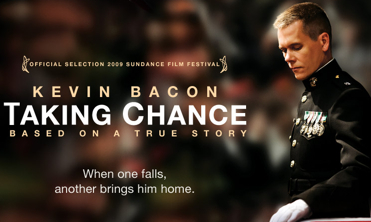The other night, Randall and I watched the HBO movie Taking Chance, starring Kevin Bacon.
We were struck by how emotional, compelling, and affecting this film was given the simplest, starkest of stories.
Essentially a high-ranking Marine (Bacon), who is a number-crunching cubicle-dweller, makes an unexpected decision to escort home the remains of a fellow Marine, a PFC. Apparently it’s unusual for an officer of the protagonist’s rank to escort the remains of a PFC.
That’s pretty much the entire story. Beginning = the decision to escort the remains. Middle = the journey of Bacon and the remains. End = arrival of Bacon and the remains at the home of the family of the fallen Marine.
As I reflected on what made such a simple story so powerful, I concluded that two factors gave the film its gravitas.
The first was the revelation of the process and ritual of the returning of military personnel killed in wartime. Americans have a vague concept of remains arriving at Dover Air Force Base, but we don’t know much beyond that. I didn’t know that each of the fallen gets a military escort back to his or her family.
The film shows many details of the process — how the bodies are cared for with love, honor, and dignity at the Dover mortuary. They are given perfect uniforms, even if their physical bodies are so mangled by war that the military recommends a closed casket so that no one ever sees the uniform. At every point in the journey home, the military escort must verify the contents of the casket and give it “honors” (a salute). Visual storytelling is key to this aspect of the film’s storytelling, with snippets of the process of caring for the remains repeated several times in the film as reminders. The entire process and ritual comprised a revelatory glimpse for me — and I would guess they would for most Americans who don’t hear about these procedures.
The second factor that gives the story power is the tacit knowledge held by many of the people Bacon encounters on his journey that he is an escort and his cargo is a fallen serviceman — from the flight attendant who gives Bacon a crucifix, to the baggage handlers who remove their hats and bow their heads as the body is removed from the plane, to the drivers of the vehicles that turn on their lights and form an impromptu funeral procession during the final drive of the remains to the family’s home. This aspect, too, is a triumph of visual storytelling.
The film serves as an excellent example that a story need not be complex or twisted to elicit a deeply emotional response.
